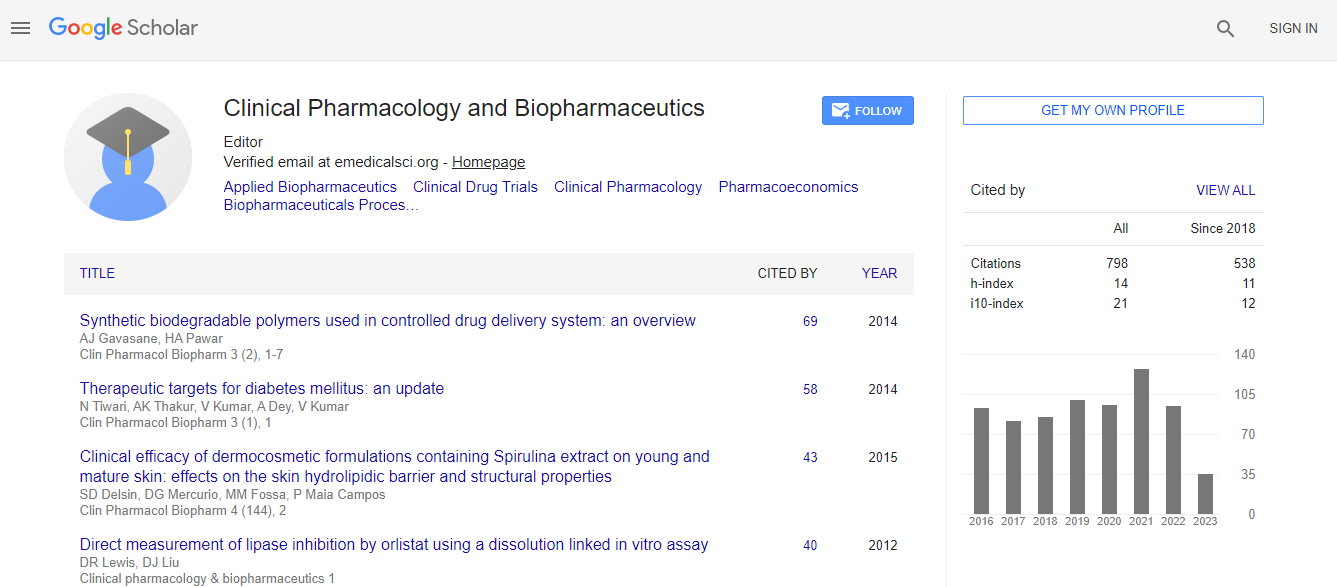Our Group organises 3000+ Global Conferenceseries Events every year across USA, Europe & Asia with support from 1000 more scientific Societies and Publishes 700+ Open Access Journals which contains over 50000 eminent personalities, reputed scientists as editorial board members.
Open Access Journals gaining more Readers and Citations
700 Journals and 15,000,000 Readers Each Journal is getting 25,000+ Readers
Google Scholar citation report
Citations : 1089
Clinical Pharmacology & Biopharmaceutics received 1089 citations as per Google Scholar report
Clinical Pharmacology & Biopharmaceutics peer review process verified at publons
Indexed In
- CAS Source Index (CASSI)
- Index Copernicus
- Google Scholar
- Sherpa Romeo
- Genamics JournalSeek
- RefSeek
- Hamdard University
- EBSCO A-Z
- OCLC- WorldCat
- Publons
- Euro Pub
- ICMJE
Useful Links
Recommended Journals
Related Subjects
Share This Page
Profile and risk of potential drug-drug interactions in intensive care unit
3rd International Conference on Clinical Pharmacy
Aline Teotonio Rodrigues, Rebeca Stahlschmidt, S├?┬şlvia Granja, Antonio Luis Eiras Falc├?┬úo, Patricia Moriel and Priscila Gava Mazzola
University of Campinas, Brazil
Posters-Accepted Abstracts: Clin Pharmacol Biopharm
Abstract
In clinical practice, drug-drug interactions can represent serious problems and the large number of Potential Drug-Drug Interactions (PDDI) found in medication profiles of ICU is notorious. This research aimed to profile risk regarding the existence of potential drug-drug interactions in intensive care patients├ó┬?┬? medication orders. It was a cross-sectional, observational study, conducted from January to December of 2011, based on medication profiles collection and assessment of an adult Intensive Care Unit (ICU) in a University Hospital of the Brazilian public health system, quantifying and classifying potential drug interactions using MicromedexTM database. Tree-hundred and sixty nine patients admitted in ICU for more than 24 hours; being 18 years or older that have valid prescription orders with 2 or more drugs were included in this study. Two hundred and five different types of drugs were prescribed, with an average of 13.04├?┬▒4.26 per medication profile. Amongst evaluated prescriptions, 89% had Potential Drug- Drug Interactions (PDDI), resulting in an average of 5.00├?┬▒5.06 drug-drug interactions per medication order. The 405 types of PDDI observed in prescriptions were classified, highlighting the prevalence of moderate and major interactions, present in 74% and 67% of prescriptions, respectively. Statistically significant correlation between the number of PDDI, length of stay in ICU and the number of prescribed drugs was also observed. The obtained results bring information about the clinically relevant potential interaction├ó┬?┬?s profile in intensive care, which is an important effort contributing to its adequate management.Biography
Email: liteotonio@gmail.com

 Spanish
Spanish  Chinese
Chinese  Russian
Russian  German
German  French
French  Japanese
Japanese  Portuguese
Portuguese  Hindi
Hindi 
